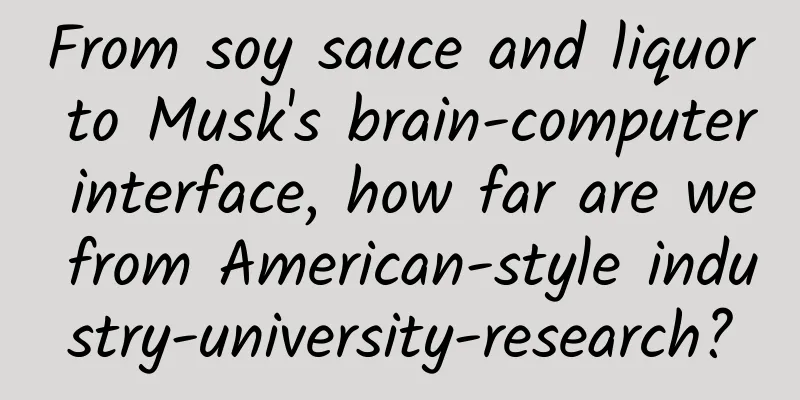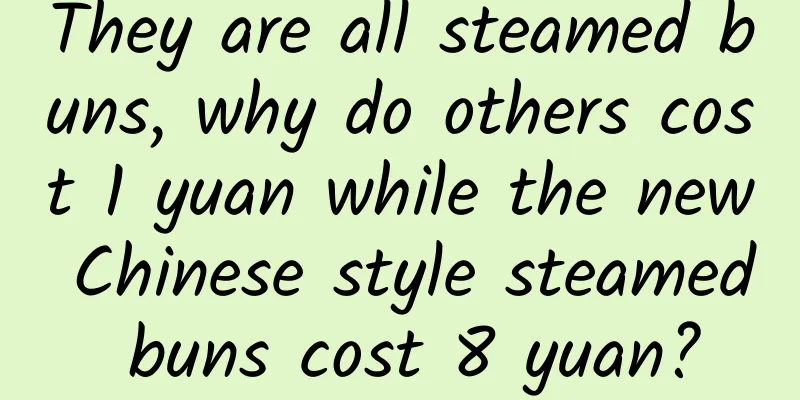From soy sauce and liquor to Musk's brain-computer interface, how far are we from American-style industry-university-research?

|
Only one year later, Musk's Neuralink company made a major breakthrough in brain-computer interface technology, applying it from early theory to real organisms. Of course, all this is first of all due to Musk's foresight. But as many netizens have lamented, "Why doesn't our country have such a cool technology company?" In fact, the reason why Musk is Musk, from a child born in South Africa to a technology giant, is closely related to the American scientific research environment that cultivated him. We can even say without exaggeration that even without Musk, the American technology tree would have produced other Musk fruits. This article does not intend to provoke any disputes or stir up any emotions, but only to state the facts and discuss the matter. The future competition between China and the United States will ultimately depend on how many "Musk" each side can cultivate. And this is precisely the decisive factor in China's future rise. Pragmatism comes first, and "soy sauce" is the hard truth Over the past decade, China's technology industry has enjoyed a boom, with both network infrastructure and terminals and related supporting industries experiencing explosive growth. Take the mobile phone industry as an example. In 2010, 99% of the top 20 mobile phone brands in China were foreign brands. Ten years later, domestic brands have successfully regained their lost ground and occupied 90% of the market. Even if it is enlarged to the global market, it is still a fantastic existence that they occupy more than half of the market share. Corresponding to the explosion of the smartphone market, the Chinese mobile game market has also seen a surge. In 2011, the scale of China's mobile game market was only 1.7 billion yuan, but by 2019, the total revenue of Tencent alone had reached 114.7 billion yuan. In just eight years, the Chinese people have created hundreds of billions of yuan in output value with their fingers. But games are just entertainment after all. They can change many things, but they cannot determine the direction of history. As Tencent Chairman Ma Huateng said in 2018, in his view, China's Internet technology industry is still big but not strong: "No matter how advanced mobile payment is, without mobile terminals, chips and operating systems, you are not strong enough to compete... China's biggest advantage in the Internet is technology application, but when it comes to basic scientific research, China's foundation is still very weak." Although what Ma Huateng said was very sharp, in the general environment at the time, most Chinese people, including Lenovo Chairman Yang Yuanqing, believed that "openness and win-win" was the main theme of the world, and that self-developed chips and systems was a unnecessary thing. Finally, two years later, under the US policy of "banning" Huawei, the Chinese people woke up. Just like Guan Hu's state of mind revealed in the movie "Eight Hundred": Four hundred people are definitely not enough, what we need to awaken are the 400 million compatriots behind us. As the Huawei incident intensified, consolidating the underlying technology has gradually become an industry consensus, but from the perspective of the capital market, capital is not optimistic about all this, or in other words, most shareholders are not optimistic about all this. Between the tangible immediate interests and long-term planning, most people are loyal to their hearts and choose the present. Taking A-shares as an example, the current market value of Haitian Flavor Industry, whose main product is soy sauce, is 593.649 billion yuan, and the combined market value of more than a dozen chip companies dubbed the "Chip Avengers" alliance is almost the same value. If Wuliangye is used for comparison, the combined market value of these "Chip Avengers" is equivalent to half a bottle of "Wuliangye". Currently, the top ten companies in the A-share market are either banks, oil or stable "real industries" such as alcoholic beverages. In contrast, the top six in the US stock market are all technology companies. Moreover, the total market value of the top ten US technology companies is almost comparable to the total market value of the A-share SME Board and ChiNext. Of course, this comparison does not mean that Haitian, banks, alcoholic beverages and other companies do not deserve such a high market value. In a market economy, these companies must have their own unique advantages to obtain such a high market value. We just want to make a horizontal comparison between the capital trend of the US market and the Chinese capital market to see the similarities and differences in the two focuses. Chips and systems don’t just pop out of cracks in the stone. They need to be built bit by bit. For China today, it’s almost starting from scratch. But now it seems that in the face of the sudden “chip disease”, in addition to more emotional fluctuations, when it comes to actual actions to support, our capital market still looks at it according to the “pure rational” standard of how much profit it makes. It takes soil, including capital, to cultivate Musk. China is catching up Musk and Neuralink can appear in the United States because of the strong underlying technological strength of the United States and the soil suitable for the survival of such technology companies in the capital market. Of course, we don't need to be depressed about this, because we still have a chance. The position of the leader of the earth's technology is not static. For example, the United States took advantage of World War II to replace Britain, France, and Germany to reach this position. Japanese science historian Yuasa Mitsuaki once concluded a conclusion known as the "Yuasa phenomenon." He said that the average rotation cycle of the world's scientific center is about 80 years. According to this theory, the United States, which has been rising since 1920, is now in a rotation cycle. In other words, the United States' position as the world's scientific center is being challenged by a cyclical emerging country, and it is self-evident who this emerging country is. Although China's underlying technological strength is not dazzling from the perspective of the capital market alone, China's huge investment in underlying technology in recent years is obvious to all. In 2017, the total global R&D expenditure was 2.2 trillion US dollars, of which the United States accounted for 25%, followed by China at 23%. Although China's overall interim data is slightly lower than that of the United States, China's annual compound growth rate in R&D expenditure is 5 times that of the United States. It is expected that by 2024, China's R&D expenditure will surpass that of the United States, which will provide a solid foundation for China's cutting-edge technology research and development. Taking the construction of the network, the "foundation of all things", as an example, in 2013, the State Council issued the Broadband China Strategy, planning that by 2020, the number of fixed broadband and 4G users will reach 400 million and 1.2 billion respectively, and the broadband access capacity is planned to exceed 50M, which directly led to the explosion of China's mobile Internet equipment and content. In terms of cutting-edge 5G networks, China's standards dominate the world. In the global 5G patent rankings, six of the top 15 companies are Chinese, including Huawei, ZTE, Datang Telecom, OPPO, VIVO and Lenovo. Qualcomm, an American wireless communications company, relied on its technological advantages in the CDMA field to charge terminal companies "Qualcomm taxes" in the 3G and 4G eras, making money without doing anything. The layout of Chinese companies in cutting-edge network technology actually implies the determination to start from scratch, which hurts the core values of the United States - where can they collect taxes in the future? Therefore, some industry experts believe that the United States' backwardness in 5G network technology and Huawei's absolute strength in 5G networks are a major inducement for the former to maliciously block Huawei. Unfortunately, due to its extreme reliance on technology accumulation and capital promotion, China is still a net importer in the field of electronic integrated circuits. In 2019, China's integrated circuit imports exceeded the US$300 billion mark. This also indirectly explains why the "Chip Avengers" Alliance is not taken seriously in the capital market - why bother to develop their own products when they can still buy them? Entering 2020, the situation suddenly changed, and the purchase of chips may really slow down. Faced with this dilemma, my country has stepped up its layout of electronic integrated circuit related technologies. According to the "Several Policies to Promote the High-Quality Development of the Integrated Circuit Industry and the Software Industry in the New Era", it is expected that by 2025, China's chip self-sufficiency rate will increase from the current 30% to 70%. Just as Britain in the 17th century became a global hegemon with its shareholding overseas trading companies, if China wants to achieve the goal of 70% self-sufficiency in its core underlying chip technology by 2025, in addition to policy-level promotion, capital-level attention is also essential. Although this trend is not very obvious from the perspective of the current capital market, according to WPP's statistics on "BrandZ 2019 Top 100 Most Valuable Chinese Brands", information technology industries such as Alibaba, Baidu, Tencent, Huawei, and DJI are beginning to emerge and occupy the top positions. The positions and proportions occupied by American technology companies such as Apple, Amazon, Google, and Microsoft in the "Top 100 Global Brand Values in 2019" are actually roughly the same trend. From this perspective, as downward pressure on the global economy continues to increase, consolidating underlying technologies will inevitably be a core element of my country's economic development in the foreseeable future. Soy sauce and liquor are certainly needed, but we really need chips and systems more. Only in this way can China cultivate more talents like Musk as soon as possible, and more technology companies with cutting-edge technologies such as brain-computer interfaces. This is the top priority for China to win the next 100 years. As a winner of Toutiao's Qingyun Plan and Baijiahao's Bai+ Plan, the 2019 Baidu Digital Author of the Year, the Baijiahao's Most Popular Author in the Technology Field, the 2019 Sogou Technology and Culture Author, and the 2021 Baijiahao Quarterly Influential Creator, he has won many awards, including the 2013 Sohu Best Industry Media Person, the 2015 China New Media Entrepreneurship Competition Beijing Third Place, the 2015 Guangmang Experience Award, the 2015 China New Media Entrepreneurship Competition Finals Third Place, and the 2018 Baidu Dynamic Annual Powerful Celebrity. |
Recommend
APP promotion tips: 100,000 yuan brings 20 million users
Last time, I wrote an article titled "How to...
Why does dandruff increase in winter?
Reviewer: Zhang Yuhong, Chief Physician, Departme...
Safety first: Sony recommends VR games should be developed for sitting and playing
Virtual reality has become the hottest technology...
Despite the hype from marketing accounts, the market share is only 0.08%, and it is hard to predict the future sales of laser TVs
At a time when the color TV industry as a whole i...
How will Japanese cars end after Takata airbag bankruptcy?
With Takata Airbag officially submitting a bankru...
Android decompilation: decompilation tools and methods
[[126320]] Preface Sometimes during the developme...
New highlights of Android 12 revealed: double-click the back of the phone to quickly perform various operations
Every year after Android and iOS are updated, wha...
Toutiao Wei Toutiao project, what content does Toutiao Wei Toutiao publish?
Wei Toutiao is a sub-function of Toutiao. It is r...
Discussing the editing of game interactive texts from the perspective of six steps
It's difficult to write #p#. last_monster_mas...
Why can QQ suddenly be deregistered? How much do you know about the great things that have been implemented in recent years?
Recently, the news that "QQ accounts can be ...
"See through" the brain! Chinese scientists "new" super microscope
Author: Shi Xiangqi and Li Chuanfu Imagine that w...
React mobile enterprise data project practice
Course Description This project starts with getti...
Get both power and fuel consumption. If you buy Changan CS75, choose the cost-effective 1.5T model.
When it comes to domestic compact SUVs priced aro...
iOS 15 vs. iOS 14: You’ll regret it after upgrading!
iOS 15 is currently in the 8th version of testing...
12 open source frameworks to watch for Java, Web, and mobile development in 2018
The Spring Festival is coming, and many developer...









